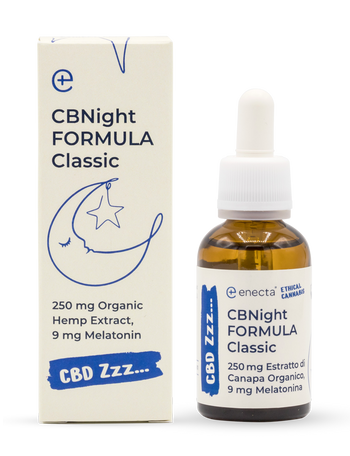What is Anandamide?
Arachidonylethanolamide, also known as anandamide, is the ethanolamine derivative of arachidonic acid, a polyunsaturated fatty acid commonly found in the central nervous system. Anandamide is produced by the body itself, provided there is enough linoleic acid and thus also arachidonic acid, making it an endogenous substance. The name of this substance comes from the Sanskrit word "Ananda," meaning bliss or joy. Chemically, it belongs to the family of lipids and shows structural similarities with THC, the psychoactive substance in cannabis. In the human body, it is produced in various tissues and is part of the endocannabinoid system, which is involved in regulating mood, pain perception, appetite, and other essential functions.
Is Anandamide a Cannabinoid?
Yes, anandamide is classified as a cannabinoid. As one of the first discovered endocannabinoids, it plays a crucial role in the endogenous cannabinoid system. Anandamide binds to cannabinoid receptors in the body, especially CB1 and CB2 receptors, similar to plant-derived cannabinoids from the cannabis plant. These interactions influence various biological processes and are critical for maintaining homeostasis or balance within the body.
What are Endogenous Cannabinoids?
Endogenous cannabinoids, also known as endocannabinoids, are a group of chemical compounds naturally occurring in humans. They are part of a complex regulatory network known as the endocannabinoid system. This system includes cannabinoid receptors, enzymes responsible for synthesizing and breaking down endocannabinoids, and the endocannabinoids themselves, including anandamide. Endocannabinoids are synthesized as needed and act locally to modulate various physiological processes.
Is Anandamide a Neurotransmitter?
Anandamide is considered a neurotransmitter, although its role is more complex than that of classical neurotransmitters like dopamine or serotonin. As a lipid molecule, it can cross the blood-brain barrier and act at neuronal synapses. It plays a significant role in neuronal signaling, influencing a variety of neurological processes, including pain perception, mood, and memory formation.
How Does the Endocannabinoid System Work?
The endocannabinoid system consists of three main components: endocannabinoids, cannabinoid receptors (such as CB1 and CB2), and enzymes responsible for synthesizing and breaking down endocannabinoids. Endocannabinoids are produced on demand by the body and act as retrograde neurotransmitters by binding to cannabinoid receptors distributed in various tissues and organs.
What Regulates the Endocannabinoid System?
The endocannabinoid system is regulated by various factors, including environmental stimuli, stress, diet, and physical activity. These influences can affect the production and release of endocannabinoids as well as the activity of cannabinoid receptors. A balanced endocannabinoid system contributes to homeostasis, while dysfunctions in this system can be associated with various diseases.
Where are CB1 and CB2 Receptors Located?
CB1 receptors are widely distributed in the central nervous system (brain and spinal cord) but are also present in peripheral tissues such as adipose tissue, pancreas, and liver. They are primarily involved in regulating pain sensation, mood, appetite, and memory. CB2 receptors, on the other hand, are mainly located in immune cells but also play a role in peripheral nervous system tissues and organs like the spleen and gut.
What Does the CB1 Receptor Do?
The CB1 receptor is one of the main receptors of the endocannabinoid system and plays a crucial role in modulating neuronal activity. When anandamide or other cannabinoids bind to this receptor, they inhibit the release of neurotransmitters such as glutamate and GABA, affecting neuronal signal transmission. This can influence the regulation of pain, mood, and memory by modulating the activity of specific neuronal circuits.
What Does Anandamide Do?
Anandamide has a variety of effects mediated by its interactions with the endocannabinoid system. Here are some of its main effects:
Pain Relief
Anandamide can reduce pain by binding to CB1 receptors in the central nervous system and modulating the release of neurotransmitters involved in pain perception.
Mood Regulation
By binding to CB1 receptors, anandamide influences the release of neurotransmitters such as serotonin and dopamine, which can improve mood.
Appetite Regulation
Anandamide plays a role in regulating appetite and energy balance. It can have both appetite-stimulating and appetite-suppressing effects, depending on the body's needs.
Anti-Inflammatory
Anandamide and other endocannabinoids can have anti-inflammatory effects by acting on CB2 receptors in immune cells and modulating inflammatory processes.
Neuroprotection
Anandamide contributes to the neuroprotective effects of the endocannabinoid system by reducing neuronal damage and protecting nerve tissue from oxidative stress.
How Does Anandamide Work Medically?
Medically, anandamide can be used to treat various conditions and diseases associated with endocannabinoid system dysfunction. These include chronic pain, inflammation, mood disorders such as anxiety and depression, neurodegenerative diseases, and more. The targeted application of anandamide or other cannabinoids could offer a natural and effective alternative to conventional treatments, especially for patients who do not respond well to or cannot tolerate traditional therapies.
Anandamide and Cannabis
Cannabis is one of the best-known plants containing cannabinoids, with tetrahydrocannabinol (THC) and cannabidiol (CBD) being the most well-known. These cannabinoids interact with the body's endocannabinoid system, which is also regulated by endogenous substances like anandamide.
The Role of THC and CBD
THC and CBD are the two most common cannabinoids in the cannabis plant. THC is known for its psychoactive effects, caused by binding to CB1 receptors in the brain and central nervous system. CBD, on the other hand, has no psychoactive properties and interacts with the endocannabinoid system in various ways, including modulating CB1 and CB2 receptors.
Synergy of Anandamide and THC
Anandamide and THC share structural similarities that allow them to bind to the same receptors in the endocannabinoid system. Through this binding, THC can mimic and enhance the natural effects of anandamide. Studies have shown that THC can increase the levels of anandamide in the body by inhibiting the breakdown of this endocannabinoid. This synergy may help explain the therapeutic effects of cannabis in pain relief, mood regulation, and appetite control.
The Influence of CBD on Anandamide
CBD indirectly affects the endocannabinoid system and influences anandamide levels in the body. One mechanism by which CBD works is the inhibition of the FAAH enzyme (fatty acid amide hydrolase), responsible for breaking down anandamide. By inhibiting FAAH, CBD increases the availability of anandamide in the body, leading to enhanced activity at cannabinoid receptors. This can help alleviate anxiety, depression, and chronic pain without causing the psychoactive effects of THC.
Therapeutic Applications and Research
The combination of anandamide and cannabinoids from cannabis opens new perspectives for medical treatment. The ability of CBD to increase anandamide levels has garnered significant research interest. This property of CBD is being intensively studied to develop potential therapies for various conditions, including epilepsy, anxiety disorders, schizophrenia, and neurodegenerative diseases like Alzheimer's and Parkinson's.
Sources
- Kurahashi, Y., Ueda, N., Suzuki, H., Suzuki, M., & Yamamoto, S. (1997). Reversible hydrolysis and synthesis of anandamide demonstrated by recombinant rat fatty-acid amide hydrolase. Biochemical and Biophysical Research Communications, 237(3), 512-515. doi: 10.1006/bbrc.1997.7180.
- Mechoulam, R., Ben-Shabat, S., Hanus, L., Ligumsky, M., Kaminski, N. E., Schatz, A. R., Gopher, A., Almog, S., Martin, B. R., Compton, D. R., et al. (1995). Identification of an endogenous 2-monoglyceride, present in canine gut, that binds to cannabinoid receptors. Biochemical Pharmacology, 50(1), 83-90. doi: 10.1016/0006-2952(95)00109-d.
- Luchicchi, A., & Pistis, M. (2012). Anandamide and 2-arachidonoylglycerol: Pharmacological properties, functional features, and emerging specificities of the two major endocannabinoids. Molecular Neurobiology, 46, 374-392. doi: 10.1007/s12035-012-8299-0.
- Reggio, P. H. (2010). Endocannabinoid binding to the cannabinoid receptors: What is known and what remains unknown. Current Medicinal Chemistry, 17(14), 1468-1486. doi: 10.2174/092986710790980005.
- Ueda, N., Tsuboi, K., & Uyama, T. (2010). N-acylethanolamine metabolism with special reference to N-acylethanolamine-hydrolyzing acid amidase (NAAA). Progress in Lipid Research, 49(4), 299-315. doi: 10.1016/j.plipres.2010.02.003.
- Arreaza, G., Devane, W. A., Omeir, R. L., Sajnani, G., Kunz, J., Cravatt, B. F., & Deutsch, D. G. (1997). The cloned rat hydrolytic enzyme responsible for the breakdown of anandamide also catalyzes its formation via the condensation of arachidonic acid and ethanolamine. Neuroscience Letters, 234(1), 59-62. doi: 10.1016/S0304-3940(97)00673-3.
- Manzanares, J., Julian, M. D., & Carrascosa, A. (2006). Role of the cannabinoid system in pain control and therapeutic implications for the management of acute and chronic pain episodes. Current Neuropharmacology, 4(3), 239-257. doi: 10.2174/157015906778019527.
- Yu, M., Ives, D., & Ramesha, C. S. (1997). Synthesis of prostaglandin E2 ethanolamide from anandamide by cyclooxygenase-2. Journal of Biological Chemistry, 272(34), 21181-21186. doi: 10.1074/jbc.272.34.21181.
- Mikawa, Y., Matsuda, S., Kanagawa, T., Tajika, T., Ueda, N., & Mimura, Y. (1997). Ocular activity of topically administered anandamide in the rabbit. Japanese Journal of Ophthalmology, 41(3), 217-220. doi: 10.1016/S0021-5155(97)00050-6.
- Woodhams, S. G., Sagar, D. R., Burston, J. J., & Chapman, V. (2015). The role of the endocannabinoid system in pain. Handbook of Experimental Pharmacology, 227, 119-143. doi: 10.1007/978-3-662-46450-2_7.
As always, please consult your doctor before using CBD if you are currently taking prescribed medications. For additional information, click here to contact a member of our customer care team.
Do you want more information about CBD?
Fill the form and download our Free Guide!

































